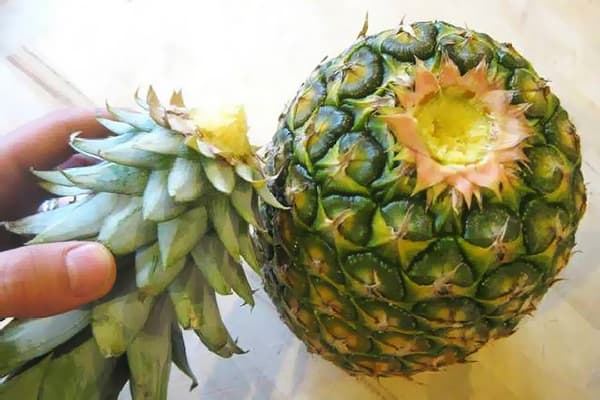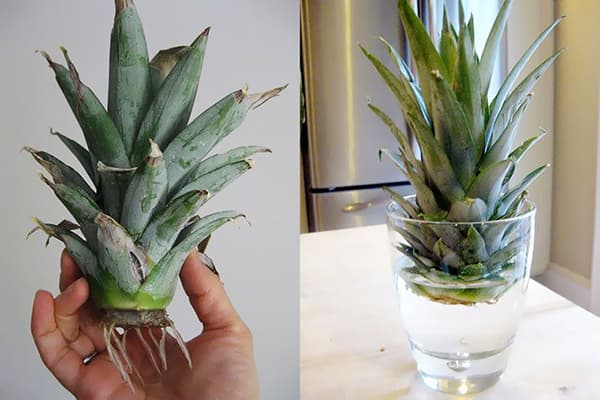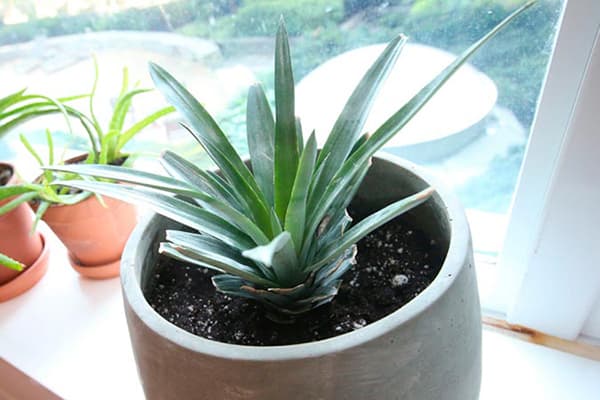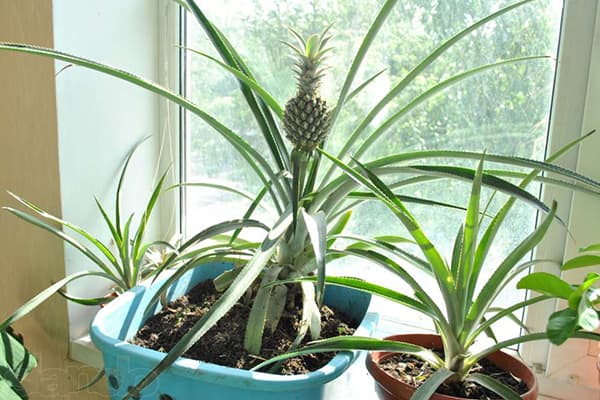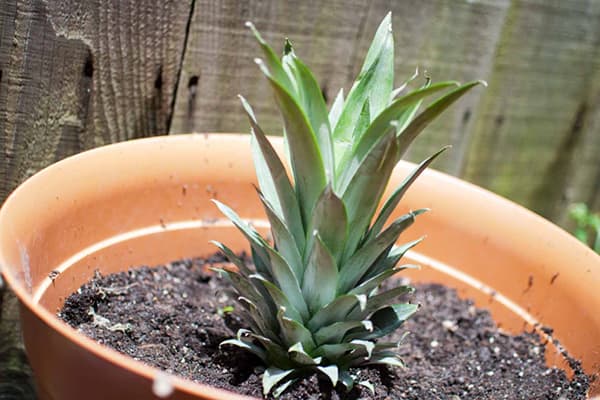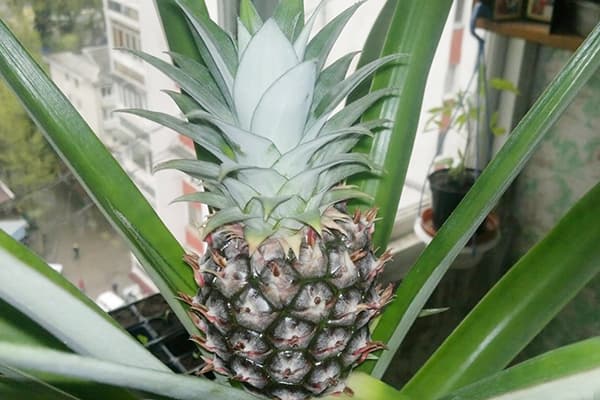How to sprout the top of pineapple and get a new juicy fruit?
Content:
Few people know that pineapple can be sprouted from the green top - the crown. The exotic plant quickly lets out roots and feels pretty good at home. With proper care, even fruits are tied on it. But first things first.
How to sprout a pineapple?
The first step is to choose the right tropical fruit. For germination, only healthy tops are suitable. When buying, you should pay attention to the basis. It should not have gray or yellow spots. A good outlet is a dense, green, saturated color.
Further course of action:
- Take the fruit in your left hand and grasp the greens at the base with your right hand.
- Scroll to the top. If she didn’t move, cut it with a sharp knife.
- Clean the bottom of the crown by about 1.5-2 cm, breaking off the leaves one at a time.
Then pineapple can be sprouted in water or planted immediately in a pot with a substrate. Some additionally dry the top for 2-4 days. To do this, they hang it on a rope in a well-ventilated area (for example, on a balcony). When drying, the places of the slices are tightened with a tissue plug, which prevents the penetration of bacteria and decay of the plant.
From one crown, 2, 3 and even 4 pineapples can be grown. To do this, it is cut with a sharp knife along and carefully dried. Germinate the split tip in separate containers. Places of cuts should not come into contact with anything, otherwise the edges will begin to rot and the plant will disappear.
Germination in water
Pineapple sprouts in the water in 10-21 days. The roots appear at the attachment of the apex to the fetus. Typically, many roots grow at once and at the end of the third week they have a length of more than 2 cm.
When germinating, it is important to observe a number of rules:
- Use glass transparent dishes. For some reason, pineapple does not like plastic containers.
- Make sure that there is only a bare base in the water, and the leaves remain dry.
- It is impossible that the base of the crown touches the bottom - so the roots will not develop.
- Change the water regularly - once every 3 days, and preferably daily.
- Settle water for at least a day.
- Pineapple will germinate at a temperature not lower than 22 degrees. Find a warm place for him.
Pineapples sprout best in small jars of fruit and vegetable purees filled with water. No need to pour it to the brim. It will be correct to leave 2-3 cm to the neck. The top is mounted on top.
In order to maintain the optimum temperature, put a pineapple for germination on a plate mounted on top of the battery. Or use the heat of the computer system unit (but in no case do not cover the ventilation openings with a jar).
Planting in a pot
Planting the top of the pineapple in the soil is recommended in the warm season, when the temperature on the windowsill reaches 20–25 degrees. In this case, you can count on a good survival rate. The optimal root length at the time of planting is 2 cm.
How to root a pineapple?
- The plant does not have a specific root neck, so you can safely deepen it. Pineapple is even useful. Its root system is superficial, while the green part is powerful, because of which, as it grows, the bush often begins to heel. Minimum landing depth –3 cm.
- To maintain the top not yet rooted, 2 pegs are dug nearby and a pineapple is tied to them.
- Immediately after planting, pineapple is watered with a warm solution of potassium permanganate. The grains are thoroughly dissolved in water and diluted to a pale pink color.
A rooted plant cannot be placed in direct sunlight. It is necessary to provide the roots with heat (+25 ° C) and high humidity.
Sometimes the appendix is covered with a glass jar so that it does not touch the leaves. Condensation forms inside, which flows down the walls into the soil. The natural circulation of water eliminates the hassle of maintaining moisture.
Not everyone sprouts the tip before planting in the ground. Subject to all the nuances of care, the plant takes root immediately into the substrate.
Pot selection
Pineapple develops well in a shallow but wide bowl. The roots of a houseplant are located in the upper soil layer and practically do not grow deep into the soil. In addition, in a wide shallow pot, soil aeration (air exchange) is better, which is very useful for the Bromeliads, which include pineapple.
It is also important that small drainage holes are present at the bottom to drain excess water. Even a small excess of moisture leads to decay of the plant. Pineapples are very vulnerable to root rot.
In conditions of natural growth, pineapple has a two-tier root system. The first tier consists of thin roots that spread along the upper layer of soil. The second tier is thin roots that go 1–1.5 m deep. Only the superficial root system develops at home.
Soil selection
Pineapple is a tropical plant and loves sandy soils. Of the finished substrates, the soil for cacti is more suitable for it than others. However, a self-made soil mixture is considered the best option.
To grow pineapple from the top, mix the following ingredients:
- 2 parts of turf land;
- 1 part peat;
- 1 part of sand.
Sand is better to take coarse, river. Drainage should be poured to the bottom - expanded clay, vermiculite, broken brick, walnut shells. The substrate must never be compacted. It must remain airy, loose.
Features of the growth of homemade pineapple
After planting, the top of the pineapple takes root from 1 to 2 months. The first sign that the plant has taken root is the growth of young leaves. They appear in the center of the outlet and have a light green color. The lower leaves gradually depart from the trunk, turn brown and die. They need to be trimmed periodically. When transplanted, the plant is buried a few centimeters more, and the trunk does not look bald.
The first flowering under favorable conditions starts in the second or third year of pineapple, approximately in May. The height of the plant by this time reaches 25 cm. The bud is formed on the top and gradually moves away from it on the growing stalk. After its appearance, flowering begins within 2 months and lasts approximately 2 weeks. Blue flowers open alternately, each for just a day.
After the last flower dries, a fetus forms. It matures from 4 to 5 months.
Since the beginning of October, the pineapple has a rest period. Its growth is suspended. Hibernation lasts until about March.
If the pineapple has already developed enough, but does not bear fruit, it is possible to stimulate flowering with calcium carbide. For this, a piece the size of an egg is poured into 2 liters of water and kept in a closed container for a day. During this time, sediment forms at the bottom. It is necessary to carefully drain the upper liquid layer and use it as fertilizer. To stimulate flowering, the solution is poured into the outlet every day for a week for 50 g.
Care requirements
For pineapples to grow well, bloom and bear fruit, they need comfortable conditions all year round. They do not tolerate hypothermia and love intense lighting, heat and moisture.
Care Features:
- Watering. Pineapple is a hygrophilous plant. In the summer it is watered every day and sprayed an additional 2 times a day. In winter, watering is reduced to 1-2 times a week. The earthen lump is not brought to complete dryness. Water for irrigation is upheld for a day or use rainwater.It must also be heated to 30 degrees and acidified to pH 5–6 with citric or oxalic acid (approximately 0.5 teaspoons of lemon per 1 liter of standing water). Watering is carried out in the socket.
- Lighting. The best place to grow pineapple is the south side of the house. The plant is not afraid of direct sunlight and should be exposed to light, at least 10 hours a day. In winter, it should be illuminated with a phytolamp.
- Temperature. Prior to rooting, the temperature of the substrate should be maintained at 24 degrees, and air - 22–26 degrees. Rooted pineapple is kept at 25–30 degrees in the summer and 20–22 degrees in the winter. It is important that the stream of warm air from the heating devices does not fall on the leaves, otherwise the tips will dry out quickly.
- Top dressing. Fertilizing is recommended every 10-15 days from March to September. Pineapples are fed with liquid complex mineral fertilizers for indoor plants, and they also use a carefully filtered solution of cow or horse manure (1 tablespoon per 1 liter of water). Monthly, the plant is sprayed with an acidified solution of iron sulfate (1 g per 1 liter of water).
- Transfer. Pineapple is transplanted into a larger pot as the roots braid the ground. On average, a transplant is carried out once a year.
Pineapple does not tolerate alkaline environment. For its fertilizer, you can not use wood ash, lime.
So, sprouting the tip is only half the battle. Pineapples need special care in order to develop and, especially, bear fruit. At home, they grow well if the room is light, warm and humid. It will properly illuminate the top with a phytolamp, since daylight hours in the homeland of pineapples are longer. You should also pay attention to the demanding acidity of water and frequent top dressing. But all efforts will certainly be rewarded. The plant not only serves as a decoration, but also gives the attentive host a tasty, fragrant fruit. They say that the taste of indoor pineapple can not be compared with the store!
